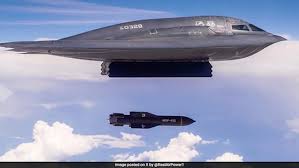
Introduction
The GBU-57, known as the Massive Ordnance Penetrator (MOP), is an advanced precision-guided munition developed by the United States. Its primary purpose is to strike fortified or deeply buried targets, making it an essential component of modern warfare. As geopolitical tensions rise globally, understanding the capabilities and significance of the GBU-57 is increasingly relevant.
Development and Specifications
The GBU-57 was developed by Boeing and has been in the limelight since its initial testing in the late 2000s. It is designed specifically for use with the B-2 Spirit stealth bomber, chosen for its ability to penetrate significant underground defenses.
Weighing about 30,000 pounds, the GBU-57 is equipped with a massive 5,300-pound penetrator warhead. It features GPS/INS guidance, which allows for precision targeting within a radius of approximately 20 feet from the intended target. The GBU-57 can be deployed from a height of around 40,000 feet, allowing for a safe distance from enemy air defenses.
Current Usage and Impact
As of October 2023, the GBU-57 is in active service with the U.S. Air Force and has been an integral part of American military strategy concerning high-value targets in hostile environments. The growing capabilities of adversaries, particularly in the context of military installations in countries like Iran and North Korea, underline the importance of such ordnance. Recent military exercises have showcased the MOP’s effectiveness, emphasizing its critical role in penetrating hardened facilities.
Moreover, with the evolving landscape of warfare, the integration of the GBU-57 alongside other precision munitions underlines the U.S. commitment to maintaining military superiority. Analysts predict that the GBU-57 will play a crucial role in future conflicts, should they arise, particularly where adversaries invest heavily in underground facilities to protect strategic assets.
Conclusion
The GBU-57 represents a significant advancement in military technology, showcasing not just a powerful weapon but also a strategic approach to modern warfare. Its ability to penetrate fortified structures defines how militaries can adapt to new threats and reinforces the necessity of maintaining a robust arsenal. As global tensions remain high, understanding the implications of such advanced weaponry becomes ever more critical for policymakers and the public alike, with the potential for its usage in international conflicts looming on the horizon.



